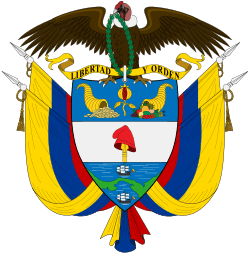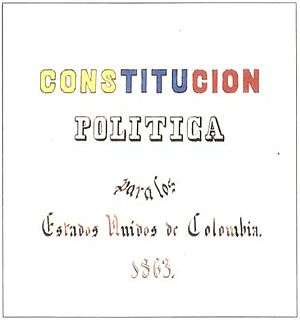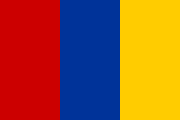Granadine Confederation
| Granadine Confederation | ||||||||||
| Confederación Granadina | ||||||||||
| ||||||||||
| ||||||||||
| Motto Libertad y Orden (Spanish: Liberty and Order) | ||||||||||
.svg.png) Location of the Granadine Confederation | ||||||||||
| Capital | Santafé de Bogotá | |||||||||
| Religion | Roman Catholic | |||||||||
| Government | Federal republic | |||||||||
| President | ||||||||||
| • | 1858–1861 | Mariano Ospina Rodríguez | ||||||||
| • | 1861 | Bartolomé Calvo | ||||||||
| • | 1861–1863 | Tomás Cipriano de Mosquera | ||||||||
| History | ||||||||||
| • | New constitution | May 22, 1858 | ||||||||
| • | Constitutional reform | 1853 | ||||||||
| • | Civil War | 1860 | ||||||||
| • | Rionegro Convention | May 8, 1863 | ||||||||
| Currency | Peso | |||||||||
| ||||||||||
The Granadine Confederation (Spanish: Confederación Granadina) was a short-lived federal republic established in 1858 as a result of a constitutional change replacing the Republic of New Granada. It comprised the present-day nations of Colombia and Panama and parts of northwestern Brazil. It was replaced by the United States of Colombia after another constitutional change in 1863.
History
The short but complicated life of the Granadine Confederation was marked by harsh opposition from the Conservative Party and the Liberal Party, which ended in a Civil War. It also was a period of hostility against the Roman Catholic Church, and of divided regionalism.
The political atmosphere that allowed the federal political system of the Granadine Confederation to happen, came to be since the Constitution of 1853, considered pro-federalism or centro-federalist because it gave more autonomy to the provinces, who multiplied reaching 35 provinces during the administration of Manuel María Mallarino (1855–1857), each with its own provincial constitution.[1]
States
.svg.png)
The centralist structure that came to be in the Republic of the New Granada after the disestablishment of the Greater Colombia and that was ratified by the constitution of 1843, was soon challenged by the independentist feelings of the different regions; particularly the provinces of Azuero, Chiriquí, Panamá, and Veraguas, who were demanding an autonomous status. The Constitution of 1853 opened the way so that on February 27, 1855, Panamá State could be created within the Republic of New Granada.
Soon others followed suit, regionalism was too strong, and in order to prevent a breakup like the one Greater Colombia had, with Venezuela and Ecuador leaving the union, congress allowed the creation of other sovereign states:
- Federal State of Antioquia was created from Antioquia Province on June 11, 1856.[2]
- Federal State of Santander, which included the provinces of Socorro and Pamplona, was created May 13, 1857.[3]
The Law of June 15, 1857 created the other states that would go on to form the Granadine Confederation:
- Federal State of Bolívar (Estado Federal de Bolívar), which included Cartagena Province.
- Federal State of Boyacá (Estado Federal de Boyacá), which included the provinces of Tunja, Tundama, Casanare, and the cantons of Chiquinquirá and Vélez.
- Federal State of Cauca (Estado Federal de Cauca), which included the provinces of Buenaventura, Chocó, Pasto and Popayán and the region of Caquetá.
- Federal State of Cundinamarca (Estado Federal de Cundinamarca), which included the province of Mariquita, Bogotá, Neiva,[4] and Tolima.
- Federal State of Magdalena (Estado Federal de Magdalena), which included the provinces of El Banco, Padilla, Santa Marta, Tenerife and Valledupar.
The nation was formed by the union of these Sovereign States which were confederated in perpetuity to form a Sovereign Nation, free and independent under the name of the “Granadine Confederation”.
In 1858 the new constituency, made up in its majority of conservatives, convened and signed the Constitution for the Granadine Confederation of 1858,[5] confirming Bogotá as its Federal Capital.
On July 12, 1861, after raising in arms against the constitutional government of the president Mariano Ospina Rodríguez, the general Tomas Cipriano de Mosquera created the Sovereign State of Tolima, carved out of the State of Cundinamarca. This was confirmed and legalized by the rest of the states of the Colombian Union, by means of Article 41 of the Pact of the Union on September 20, 1861, reaffirming the legality of the institutionalism of Tolima.[6]
Constitution of 1858
Under the conservative mandate of Mariano Ospina Rodríguez, Congress passed and approved a new Constitution for the country on May 22, 1858.[7] In this constitution, the country was officially named as the Granadine Confederation and conformed by eight sovereign states.
More power and representation was given to the provinces, as each state could have its own legislature and elect its own president.
The vice presidency was abolished and replaced with a dignitary named by the Congress.
The president and senators could be elected to serve a period of four years and the Representatives of the House for two.
The Constitution also listed the powers and obligations of the states and of the central government, gave parameters to creating new laws, and amending the constitution. It included the basic freedoms, and rights of the people. The constitution was important as it signaled the official beginning of the confederacy and set legal parameters for the leaders.
Civil war

Even though the Constitution of 1858 had legalized federalism, the politics of the president Mariano Ospina Rodríguez leaned to centralism. This conservative outlook clashed with the wishes of the states who wanted more power and autonomy.
This led to some leaders to see the administrative base of the federation as a notion to underestimate the authority of the states, and led the national government to view the independent aspirations of the states as a threat to the overall nation.
The political tension came to its pinnacle in 1859 when Congress passed two controversial laws. On April 8, 1859, Congress passed a law giving the President the right to remove the duly appointed governors of the states and appoint one of his choosing. With this law, the president secured the power of the Conservative Party.
On May 10, 1859, another law was passed, this one giving the president the power to create administrative departments in states so to control their resources and how would they be used.
These laws angered many liberal leaders, specially general Tomás Cipriano de Mosquera, an ex-president of New Granada, and a powerful and influential politician in the country. He denounced these laws as unconstitutional and made contact with other liberal leaders in other states, who gave him their support to revolt against the president, even though not all agreed with his ideas, they supported him and accepted to allow him to become Supreme Director of War, because they saw no other way to get back their autonomy than to revolt against the government.
By a decree of May 8, 1860, Mosquera broke relations with the national government, declared himself Supreme Director of War, and declared a separated state, the Sovereign State of Cauca. From that moment the country entered a civil war.
In retaliation, the government of Ospina Rodríguez supported insurrections against the liberal governments in some states, the first of these armed conflicts in Santander, against the government of Eustorgio Salgar in 1859; the Granadine Confederacy declared war on the state of Santander, and sent its army to subdue Eustogio Salgar, who was taken prisoner along with other important figures, like Aquileo Parra.
Civil war then spread to other states, like Bolívar, Antioquía, Magdalena and Cauca. In an unexpected move, Mosquera captured Bogotá on June 18, 1861, declared himself president of the provisional government, and arrested Ospina Rodríguez, his brother Pastor Ospina, and Bartolomé Calvo, the newly elected president of the confederacy.
The war ended in 1862 when the last leaders of the conservative opposition died or gave up.
Geography
Part of a series on the |
||||||||||||||||||||
|---|---|---|---|---|---|---|---|---|---|---|---|---|---|---|---|---|---|---|---|---|
| History of Colombia | ||||||||||||||||||||
 | ||||||||||||||||||||
| Timeline | ||||||||||||||||||||
|
||||||||||||||||||||
|
| ||||||||||||||||||||
Borders
According to the constitution of 1858, the limits of the territory of the Granadine Confederation were to be the same that in the year 1810 divided the territory of the Viceroyalty of the New Granada, from the Captaincy General of Venezuela, the Captaincy General of Guatemala, and the Portuguese positions in Brazil. In the west, the limits would be those provisionally marked by the treaty with the government of Ecuador on July 9, 1856, and all those treaties that in those days divided that republic.
Regions
The Granadine Confederation occupied a vast region, sharply divided by its geography. The three cordilleras divided the country into three distinct regions, the Magdalena River the main artery of navigation in the country, divided some of the states, and the Isthmus of Panama was isolated in its region. The deep jungles in the south only added to the confusion. The unclear borders were never definitively marked, and the terrain secluded its residents, mostly natives, from the rest of the country.
Four isolated regions divided the country; the Oriental Region included Cundinamarca, Tolima, Boyacá and Santander; the Cauca Region, which included Chocó and extended to Marmato; the Region of Antioquía, that extended down to the River Chinchiná near Manizales; and the Atlantic Region.[8]
Each of these regions behaved like a separate country without relations to the others. This isolation and lack of roads was a severe restraint on the economy, as its already distant nuclei were too far off each other for trade to grow and investment to take place.
Religion
In the short life of the Granadine Confederacy, the Roman Catholic Church was a constant target for the government. Although its population was still very highly Roman Catholic, and religion formed an essential part of every citizen, the government passed a number of laws directed at controlling the clergy and church property during this time.
During the first presidency of general Tomás Cipriano de Mosquera in 1849, Mosquera adopted a radical position with the church, passing laws confiscating religious property and subjecting the clergy to government rules. He banished and expelled the Society of Jesus from the Republic of New Granada, expelled the Archbishop of Bogotá. The closure of convents and monasteries drove nuns into poverty, although many were taken into homes by citizens. All of this drew direct criticism from the Vatican, even leading Pope Pius IX to directly condemn the government of Colombia for its actions.
After the creation of the Granadine Confederation, during the government of Mariano Ospina Rodríguez, the Jesuits were once again welcomed into the country and religious tensions eased.
This short period of religious calm ended when Mosquera, who assumed the presidency a second time, continued with his anticlerical attitude driving once again the Jesuits off the Confederacy giving them only seventy-two hours to leave the country or face imprisonment, as he blamed them of supporting the insurgency.[9] He passed a couple of anticlerical laws. One of these was the Tuition of Cults, a law that prohibited religious leaders to exercise their functions without authorization from the government, thus requiring special licenses to preach.[10] Through another law, he confiscated the property of religious communities and organizations such as schools, hospitals, monasteries, churches, land, houses and other properties that could be sold. Those organizations that opposed were banned and abolished.
These laws were not passed as a direct attack on the Church, but what was pretended was to improve the situation of the national treasury which was severely depleted because of the Civil War currently being waged. The Church assets were sold to the best buyer, improving industry and investment while putting money in the hands of the state. However the laws provided little assistance to the farmers who finished up owning little of the land as Mosquera intended, with his slogan of “Land for those who work it”.

Rionegro Convention
The Granadine Confederation came to an end on May 8, 1863, with the signing of the Constitution of 1863 by the Rionegro Convention, which officially changed the name of the country to the United States of Colombia, consisting of nine Sovereign States, and where new rules and powers were given to the States and Presidents. The Liberals had come to fear the great power Mosquera held, and they drafted the new constitution to limit his power and prevent him from turning against them, as he had done with the Conservatives. The Radical Liberals defended a federal government based on a laissez-faire policy, in which the regional and local autonomy were protected, where there was no National Army, a society with the basic rights and freedoms, based on education and Open Market values, with no intervention by the Church.[11]
See also
Notes
- ↑ http://www.lablaa.org/blaavirtual/revistas/credencial/agosto1994/agosto1.htm Federalism in the 9 sovereign states
- ↑ "Law of the Creation of the State of Antioquía". Cervantes Virtual.
- ↑ http://www.cervantesvirtual.com/servlet/SirveObras/01371296677834897430035/p0000001.htm#I_1_ Law of the Creation of the State of Santander
- ↑ http://www.loscolombianos.com/departamentos-de-colombia/cundinamarca.html Provinces of The Sovereign State of Cundinamarca
- ↑ http://www.cervantesvirtual.com/servlet/SirveObras/01477398877125528632268/index.htm Constitution for the Granadine Confederation of 1858
- ↑ http://www.sedtolima.gov.co/website/actividades/TOLIMA%20CREACION%20Y%20DESARROLLO%20INSTITUCIONAL....doc Tolima, Creation and Institutional Growth
- ↑ http://www.cervantesvirtual.com/servlet/SirveObras/01477398877125528632268/p0000001.htm#I_2_ Constitution of 1858
- ↑ http://www.raicespaisas.org/independencia_.htm Four Isolated Regions
- ↑ Jesuitas | documentos | Encuentros con la Palabra
- ↑ :: Presidencia de la República de Colombia ::
- ↑ http://www.cervantesvirtual.com/servlet/SirveObras/07030730122947295209079/index.htm Political Constitution for the United States of Colombia
Coordinates: 4°39′N 74°03′W / 4.650°N 74.050°W

